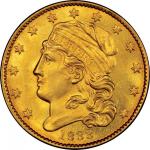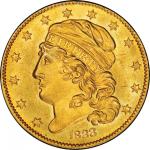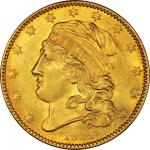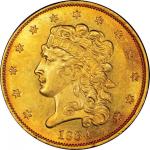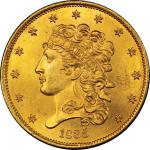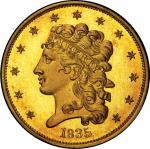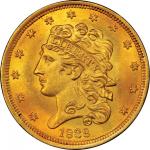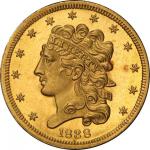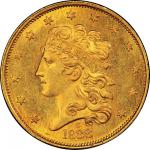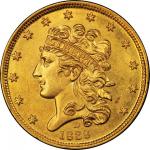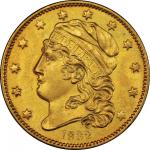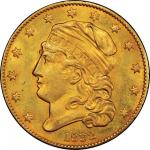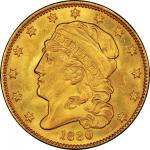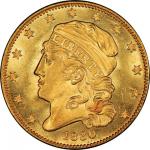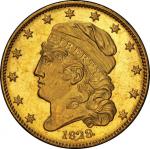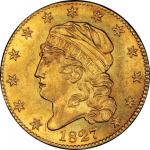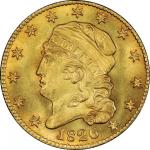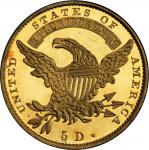Pittman, with his yen for early Proofs, paid $630 for the 1833 Proof half eagle, a super rarity worth five figures and not too low in that bracket either. Pittman continued to buy the Proofs. In lot 248 he got the 1835 and 1836 large 5D, both brilliant Proofs. For his $480, he got a few extras, like the 1836 small 5D, 1837, 1838-C, and 1838-D, the latter two pieces worth a few thousand dollars.” — Abe Kosoff, “Farouk Bargains: What are they worth?” Coin World, December 28, 1977</em>If the half eagles of the Pogue Collection were to be evaluated on no other basis but their beauty and proximity to perfection, the dozens of landmark examples of this denomination found in this collection would need to find their place in line behind this one. Its surfaces shine with the deepest maize yellow color, rich and even, relenting only for the coppery orange spot near star 3 and the splash of similar color near D of UNITED. The devices are uniformly bold and realized in extraordinary relief. Star centers, eagle talons, feathers, arrowheads, and other design elements are finely detailed, though it is instructive that the curl near Liberty’s ear is still not quite fully rounded even on a coin so soundly and purposefully struck as this one. The fields are glassy and luminous, matched by the polished letters at the beginning and end of Liberty’s cap band and the pales of the eagle’s shield. Verbiage does not exist to express the way this coin shines, nor the majestic impact a piece of metal barely one inch across could create.The flaws on this coin were almost entirely created at the moment of striking. All are minor. The parallel lines on the planchet were nearly all struck out but for a few, including one that runs through the field near star 3 but is more visible on Liberty’s chin. Shorter vestiges, including one between star 5 and the forelock and another left of star 7, run perfectly parallel. A tiny curved lintmark impacts the field off Liberty’s chin. Shallow circular depressions, likely from a drop of something liquid or nearly that consistency on the die surface at the moment of striking, are seen on the reverse at the base of 5 in the denomination and below U of UNITED; a patch of granularity from a similar struck-through process, sometimes called a “planchet chip,” hides between the tops of ED of UNITED.In preparation for Proof strikings from these dies, the reverse was notably lapped, creating reflective spaces near the talon at left and the arrow feathers. The Mint Cabinet coin, still in the National Numismatic Collection at the Smithsonian Institution, is struck from an identical early die state. It is the only other gem Proof example of this date known. A third lightly handled Proof, certified as Proof-61 (NGC), most recently sold in October 2012.This coin’s provenance can be confidently traced to the 1890 Parmelee sale, where its image stands out boldly from Plate 12. H.P. Smith’s salesroom copy of the Parmelee sales catalog lists “Parm” as the buyer of this lot and the one that followed it, a Proof 1833 quarter eagle; though the overwhelming majority of Parmelee’s coins found new homes after the auction of his collection, apparently Parmelee liked these two enough that he bought them back. Parmelee probably acquired this coin from his 1873 purchase of the cabinet of George A. Seavey, whose 1833 half eagle was described as Proof in the 1873 <em>Descriptive Catalogue </em>of his collection, but how Parmelee sold it is unknown. It may have later sold to one of the primary buyers of his gold coins, William H. Woodin, whose half eagles were acquired in the early 1920s by Waldo Newcomer of Baltimore. The first photographic proof of this piece’s ownership after the Parmelee sale comes from the 1931 Newcomer plates, which illustrate this coin. The provenance of this piece follows that of most other Newcomer half eagles, selling to E.H.R. Green, and later to King Farouk. Despite being published as such by Walter Breen and David Akers, it is very unlikely the coin sold as lot 938 in the J. Colvin Randall sale of June 1885 is this coin. W. Elliot Woodward, who used the word Proof casually, called Randall’s coin “Uncirculated, or Proof.” Anyone who has held this coin in hand can testify to the fact that, then or now, there is no mistaking its Proof fabric, and a description that offers even the faintest inclination of doubt of the Proof status of the coin described necessarily eliminates this coin as a potential provenance match. Its $19.50 high bid was in the middle of a range of $15 to $32 among Capped Head, Small Diameter half eagles in the sale, not a price befitting the extraordinary visual appeal or rarity of this piece.Among the 8,500 gold coins that were amassed by King Farouk during his reign, few are as important as this one. His superb collection of United States gold coins was sold over slightly more than 100 lots. This coin was sold on its own, as was the legendary 1907 double eagle pattern known as Judd-1776, but most others were placed into large group lots. A large lot of double eagles was withdrawn on the day of the auction; one of the 17 coins included therein, a $20 gold piece dated 1933, would later become the most valuable coin in the world, sold in the Sotheby’s auction gallery where this coin will also find its next owner.The auction was no secret, but the barriers to bidding were immense. Travel to Egypt in the days after the Revolution was touch-and-go. Rumors flew: that Jewish dealers would not be allowed to participate, that Farouk would be organizing a group to buy all the coins back, that the sale was cancelled entirely. A small group of American dealers and collectors made the trip, including John Jay Pittman. Pittman was already an advanced collector by 1954, well known for both his wide-ranging interests and exacting tastes. He did enough business with the dealers present that some of the good deals that fell into his lap were not entirely accidental. Abe Kosoff, who wrote extensively in the 1970s about his experiences at the Farouk sale, related that certain planning sessions were held in advance, but never in the same place twice because rooms and phones were known to be bugged.Amidst this challenging environment, Pittman held his own, adding coins of great significance to his cabinet. The Proof 1835 half eagle offered in the present catalog was purchased in a group lot, and other gems were similarly cataloged. This coin, called “brilliant Proof and excessively rare” by Fred Baldwin in the Farouk catalog, was perhaps the biggest prize he captured in Cairo. When Mark Van Winkle asked Pittman in 1988 how he did at the Farouk auction, Pittman simply replied, “Very well, thank you.” In 1997, after Pittman’s passing, David Akers included this coin in Part I of three separate catalogs of Pittman’s collection. He praised it as “a magnificent, stunning coin which, in my opinion, is the premier coin in the entire Pittman Collection.” Calling it “his personal favorite,” Akers added that “I consider it to be one of the greatest coins that I have ever seen.”Rarity and preservation coalesce at their highest levels around this coin. PCGS has certified only two Proof half eagles of this entire design type, the other being an 1832 in Proof-64, and the only other privately owned Proof of this date has been lightly circulated. Even among later Proof half eagles, the quality of this piece is all but unsurpassed: the oldest Proof half eagle to receive a higher numerical grade from PCGS is dated 1898. PCGS# 8167. NGC ID: 28B9.

